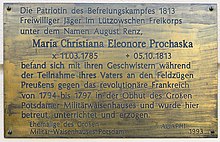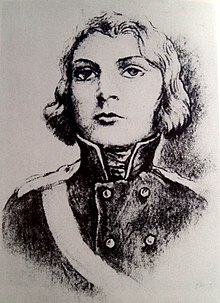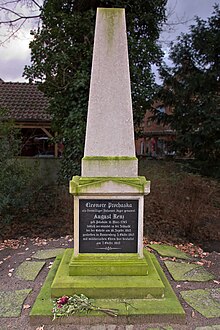Eleonore Prochaska
Marie Christiane Eleonore Prochaska (born March 11, 1785 in Potsdam , † October 5, 1813 in Dannenberg ) was a German soldier in the Wars of Liberation .

Life
Eleonore Prochaska was born on March 11, 1785 in Potsdam. Her father was a sergeant in a Prussian battalion of the Guard. When he had to go to war against France in 1793, his mother was unable to look after the children. Eleonore and her three siblings were sent to the Great Military Orphanage in Potsdam. She stayed there until 1797 and then returned to her father, who had left the service and lived on his pension and music lessons. Around 1808/1809 she was interested in the popular uprisings in Spain and Tyrol against Napoleon. Around this time she left her father's household and around 1810 she served as a cook in a Potsdam town house.
At the end of June 1813 she entered the regular role of the hunter detachment of the 1st Battalion of the Lützow Freikorps under the name August Renz . Lieutenant Otto Preuße wrote:
- “We were in Sandau on the Elbe. Here a hunter Renz came to the company - as it turned out later, a girl named Prochaska. He became a wingman, 5 feet, 8 inches, 3 lines high - English shoes were delivered to us, all of them significantly too big, but too small for Renz and I had to work a pair especially for him. His language was not particularly fine, so that no one could suspect a girl in him. Incidentally, he cooked splendidly in the bivouacs. "
In July 1813, the Lützow Freikorps reinforced General Wallmoden's army corps , which was positioned on the Lower Elbe. When the war broke out again in mid-August, Prochaska's unit was in Büchen . Your department participated in the whole campaign, but was not used in the many skirmishes against the army of Davout (Lauenburg, Vellahn, Gadebusch, Mölln, etc.). The battle of the Göhrde on September 16, 1813 was the first serious combat test for the company and for Prochaska.
In the Battle of the Göhrde , she was badly wounded by a grapeshot when she tried to carry an injured comrade out of the battle line. A superior who rushed to take care of her wounds discovered her true gender and had her taken to a community center in Dannenberg, where she succumbed to her injuries three weeks later.

Honors
A newspaper report dated October 7, 1813 reported:
“This morning at 9 o'clock the corpse of Eleonore Prochaska, who was wounded in the battle of Göhrde and who, as a hunter in the Lützow Corps, had consecrated her arm to the sacred cause of the fatherland out of pure patriotism, was buried on earth. Like a Jeanne d'Arc, she had bravely fought the fight for king and fatherland […] The Hanoverian and Russian-German hunter corps, Se. Excellency the Minister and Grandmaitre de la Garderobe, Envoy Extraordinary Count von Grote, your Commander and Colonel, Count von Kielmannsegg, with all officers at the head, and gave their courage the final proof of public appreciation of excellent valor and female heroism. "
In the following years she was strongly idealized as a virgin heroine and revered as the "Potsdam Joan of Arc ". Various dramas and poems have been written about her, including Auf das Mädchen from Potsdam, Prochaska by Friedrich Rückert . She is the protagonist in Birgid Hanke's historical novel Flamme der Freiheit (2013).
In 1865 a memorial was erected on her grave in the St. Anne's Cemetery in Dannenberg and in 1889 her hometown Potsdam received a memorial in her honor ("The Hero Virgin in Memory"), which has been preserved in the almost completely cleared Old Cemetery Has.
A remarkable monument was also placed on her musically: Ludwig van Beethoven composed, in memory of the heroine, for the (lost) play Leonore Prohaska , written by the Royal Prussian secret secretary Friedrich Duncker (1815), an incidental music consisting of a warrior choir and a romance , a melodrama and a funeral march (work without Opus 96).
The myth of the Lützow drummer
Lieutenant Friedrich Christoph Förster , who took part in the attack by the Lützower on the Göhrde, told in his book published in 1863 how Prochaska, in order to encourage her comrades, continued the attack with a drum that had been abandoned. When she was badly hit, she was able to reveal her feminine nature to Förster: "Lieutenant, I am a girl."
The story of the drummer immediately spread widely and today it is still impossible to imagine Prochaska without this image of the Lützow drummer.
However, this report by Förster was invented by him. All previous sources agree on the fact that Prochaska was hit when she was trying to carry a comrade away from the firing line and that she revealed herself not to Lieutenant Förster, but probably to Sergeant Markworth, a schoolteacher from Berlin.
Her person has been reinterpreted over and over again and over the years has experienced several appropriations from different political directions. Prochaska gradually became a symbol of patriots, nationalists, war advocates, communists and feminists.
Prochaska and gender research
Since the 1990s, gender studies (with, for example, the German historian Karen Hagemann) have offered a new interpretation of Prochaska's figure. With the introduction of compulsory military service in Prussia after the devastating defeat of Jena in 1806 and during the wars of liberation in 1813, a new form of masculinity would have crystallized. The man becomes a national warrior and citizen and a “patriotic” femininity develops as a counterpart to the courageous male fighter. Women are given the role of “hero mothers”, “warrior brides” or “generous nurses”. In this context Prochaska appears (like the other women who fought in the wars of liberation) as a person who for patriotic reasons does not accept and exceeds the scope of her intended role as a woman. Prochaska goes to war not only to fight, but also to fulfill her duties as a citizen.
Other women in the wars of freedom
In addition to Eleonore Prochaska, other women fought in the armies involved during the wars of freedom, such as the Russian officer Nadeschda Durowa or the Tyrolean Katharina Lanz . However, almost all of them were discharged from military service after they were recognized as women. The only exception was probably Friederike Krüger (1789–1848), who, thanks to the protection of her brigade commander, became the only known female sergeant in the Prussian army. Most recently she served on foot in the 2nd Guard Regiment. In 1816 her resignation was granted and she withdrew into civilian life.
Even Anna Lühring (1796-1866) joined the 1814 Lützower hunters as hunters Eduard Kruse and survived the wars of liberation. Their myth quickly faded.
The Lüneburgerin Johanna Stegen (1793-1842) procured as a civilian in a battle near Lüneburg ammunition for the Fusilier Battalion of the 1st Pomeranian Infantry Regiment.
See also
literature
Printed sources
- Fanny Arndt: The German women in the Wars of Liberation . Halle 1867, pp. 173–192 ( full text in the Google book search).
- I. von Brun-Barnow: Eleonore Prochaska, as August Renz, volunteer hunter in the Lützow Freicorps. In: Bear. Volume 9, 1883, pp. 200-202.
- Wilhelm Herchenbach: German spirit and German sword - three years of war against foreign oppression. Regensburg 1866, pp. 121–124 ( full text in the Google book search).
- Friedrich Förster: History of the Wars of Liberation 1813, 1814, 1815. Volume 1, Berlin 1856.
- Louis Noel: The German heroines in the war years 1807–1815. Berlin 1912.
- Bernhard von Poten : Prochaska, Eleonore . In: Allgemeine Deutsche Biographie (ADB). Volume 26, Duncker & Humblot, Leipzig 1888, p. 621 f.
- Schelowsky: Eleonore Prochaska, the hero girl of Potsdam. In: Communications of the Association for the History of Potsdam. 1867, pp. 137–143 ( full text in the Google book search).
- Hermann Stodte : The Prussian girl. Eleanor Prochaska's fateful ways. Publisher AW Hann's Erben, Berlin after 1917.
- A German Amazon. Memory from the wars of freedom. “Die Gartenlaube” 1855, no. 43, pp. 576-578.
- Elisabeth Meyn: The women of the wars of liberation in the mirror of the press. In: Emmy Wolff, ed .: Generations of women in pictures. Herbig, Berlin 1928, pp. 56-64.
reception
- Beate Klompmaker: Eleonore Prochaska, settings of Beethoven's funeral march for Eleonore Prochaska, Sonata No. 12, Op. 26 and original letters from Eleonore Prochaska: "From our last bivouac ...", "Dear brother ..." , 1813 (eleonoreprochaska.de: Eleonore Prochaska - Prussia's Jeanne d'Arc / Sound ).
- Birgid Hanke : Flame of Freedom. The story of Eleonora Prochaska. Novel. Knaur Verlag, Munich 2013, ISBN 978-3-426-50877-0 .
- Gudrun Parnitzke: A dream from Prochaska. Dahlem 2013.
- Katharina Rothärmel , Beate Klompmaker: Eleonore Prochaska (1785–1813). The drummer of the Lützower. A story by Katharina Rothärmel and Eleonore Prochaska - a kind of monument. A media art project by Beate Klompmaker, Trafo Verlagsgruppe , Berlin 2011, ISBN 978-3-89626-973-7 .
Secondary literature
- Marc Bastet, Susanne Götting-Nilius: Eleonore Prochaska, died in Dannenberg in 1813, facts, myths, history of reception . Gifkendorf 2014 ISBN 978-3-87536-311-1 .
- Marc Bastet, Susanne Götting-Nilius: Eleonore Prochaska: The myth of the drummer. A re-examination of older sources. In: Yearbook Hannoversches Wendland , Vol. 18 (2012–2015), Lüchow 2015, pp. 207–226 Table of contents of the yearbook .
- Matthias Blazek: The Electorate of Hanover and the years of foreign rule 1803-1813 . Ibidem, Stuttgart 2007, ISBN 3-89821-777-9 , pp. 73 f.
- Ernst Andreas Friedrich : The monument in the Göhrde. In: If stones could talk. Volume 2, Landbuch-Verlag, Hanover 1992, ISBN 3-7842-0479-1 , pp. 173-175
- Karen Hagemann: "Mannlicher Courage and German Honor". Nation, military and gender at the time of the Antinapoleonic Wars in Prussia. Paderborn 2002.
- Karen Hagemann: 'Heroic Virgins' and 'Bellicose Amazons': Armed Women, the Gender Order and the German Public during and after the Anti-Napoleonic Wars. In: European History Quarterly. Volume 37, 2007, pp. 507-527.
- Ulrike Hass-Zumkehr: I am a soldier - Eleonore Prochaska. In: Another Germany: Texts and Images of Resistance from the Peasant Wars to Today. Berlin 1978, p. 124.
- Axel Kahrs: relic or residual waste? The restless afterlife of the soldier Eleonore Prochaska from the liberation war of 1813. In: Der Heidewanderer. 89th year (43), Uelzen 2013.
- Werner H. Preuss: The face of Göhrde. Husum 2006.
- Helen Wanatabe-O'Kelly: Beauty or Beast? The Woman Warrior in the German Imagination from the Renaissance to the Present. Oxford 2010.
- Charlotte Thomas: The girl from Potsdam. Gebr. Knabe Verlag, Weimar 1964.
Web links
- Literature by and about Eleonore Prochaska in the catalog of the German National Library
- Eleonore Prochaska
- Biography of Eleonore Prochaska on EPOCHE NAPOLEON ( Memento from January 6, 2009 in the Internet Archive )
- Short résumé
- Veronika Bock and Ulrich Biermann: 11.03.1785 - birthday of Eleonore Prochaska WDR ZeitZeichen from 11th March 2020 (podcast)
Individual evidence
- ^ Letters from Prochaska to her brother. The first version of these letters appeared in the Berlinische Nachrichten von Staats- und schehrte Dinge, No. 122, October 12, 1813. Later versions show considerable corrections and changes.
- ↑ Klaus Ulrich Keubke / Uwe Poblenz, The Freikorps Schill and Lützow in the fight against Napoleon, Writings on the history of Mecklenburg, Vol. 24, Schwerin 2009, p. 76.
- ↑ Louis Noel, Die deutscher Heldinnen in die Kriegsjahren 1807-1815, Berlin 1912, p. 43. The indication of body size "3 feet, 8 inches, 3 lines high" is a frequently repeated citation error in literature.
- ↑ Bastet / Götting-Nilius: Eleonore Prochaska, died in Dannenberg in 1813, facts, myth, reception history, Gifkendorf 2014, p. 20.
- Jump up ↑ Berlinische Nachrichten von Staats- und schultten Dinge, No. 120, October 7, 1813.
- Jump up ↑ Berlinische Nachrichten von Staats- und schultten Dinge, No. 126, October 21, 1813.
- ↑ See on the topic: Werner H. Preuß: The face of Göhrde, Husum, 2006, pp. 20–21, Axel Kahrs: “Reliquie oder Restmüll? The restless afterlife of the soldier Eleonore Prochaska from the liberation war of 1813 " , Der Heidewanderer, 89th year (43), Uelzen 2013, Bastet / Götting-Nilius: Eleonore Prochaska, died 1813 in Dannenberg, facts, myth, reception history, Gifkendorf 2014, Pp. 27, 38-39.
- ↑ Summary in: Bastet / Götting-Nilius: Eleonore Prochaska, died in Dannenberg in 1813, facts, myth, reception history, Gifkendorf 2014, pp. 44–65.
- ↑ Karen Hagemann: Hero Mothers, Warrior Brides and Amazons. Drafts of "patriotic" femininity during the wars of freedom. In: Ute Frevert (Ed.): Military and society in the 19th and 20th centuries. Stuttgart 1997, pp. 174-200.
- ↑ life data 1883–1951; better known as "Elisabeth Meyn-von Westenholz" or just "von Westenholz"; Meyn has been her married name since 1921
- ↑ to Leonore (sic) Prochaska P. 58f .: in it a poem by NN on the dead as well as excerpts from letters from the EP to her brother about her motives.
| personal data | |
|---|---|
| SURNAME | Prochaska, Eleanor |
| ALTERNATIVE NAMES | Renz, August (pseudonym) |
| BRIEF DESCRIPTION | German freedom fighter under Napoleonic rule |
| DATE OF BIRTH | March 11, 1785 |
| PLACE OF BIRTH | Potsdam |
| DATE OF DEATH | October 5, 1813 |
| Place of death | Dannenberg |


